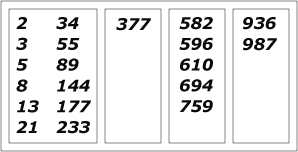
Fibonacci number f(i) appear in a variety of puzzles in nature and math, including packing problems, family trees or Pythagorean triangles. They obey the rule f(i) = f(i - 1) + f(i - 2), where we set f(0) = 1 = f(-1).
Let V and d be two certain positive integers and be N ≡ 1001 a constant. Consider a set of V nodes, each node i having a Fibonacci label F[i] = (f(i) mod N) assigned for i = 1,..., V ≤ N. If |F(i) - F(j)| < d, then the nodes i and j are connected.
Given V and d, how many connected subsets of nodes will you obtain?

Figure 1: There are 4 connected subsets for V = 20 and d = 100.
Each data set is defined as one line with two integers as follows:
Line 1: Number of nodes V and the distance d.
Input includes several data sets (i.e., several lines). The number of dat sets is less than or equal to 50.
Output line contains one integer - the number of connected subsets - for each input line.
5 5 50 1 13 13
2 50 8